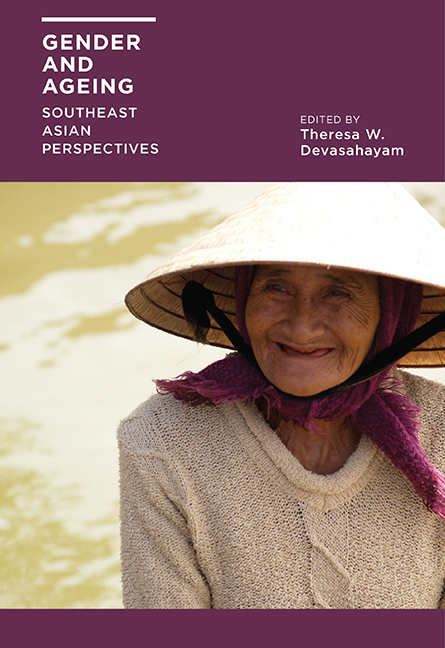Book contents
- Frontmatter
- Contents
- List of Tables and Figures
- Acknowledgments
- Contributors
- 1 Growing Old in Southeast Asia: What Do We Know about Gender?
- 2 Gender and Ageing in Thailand: A Situation Analysis of Older Women and Men
- 3 Gender and Well-being of Older Persons in Cambodia
- 4 Preparations for Old Age and Social Participation of Present and Future Older Persons in Thailand: Gender Difference
- 5 Gender and Health Status among Older Adults in Vietnam
- 6 Ageing and Gender Preferences in Rural Indonesia
- 7 Exploring the Experiences of Older Men and Women in Caregiving and Care-receiving in Sarawak, Malaysia
- 8 An “Active Ageing” Approach to Living Alone: Older Men and Women Living in Rental Flats in Singapore
- 9 Ethnic Patterns and Styles of Active Ageing among Widows and Widowers in Singapore
- 10 Employment Patterns of Older Women in Indonesia
- 11 Gender Differentials in Work and Income among Older Malaysians
- 12 Gender and Economic Well-being among Older Filipinos
- 13 Work, Retirement and the Gender Divide in the Philippines
- Index
9 - Ethnic Patterns and Styles of Active Ageing among Widows and Widowers in Singapore
Published online by Cambridge University Press: 21 October 2015
- Frontmatter
- Contents
- List of Tables and Figures
- Acknowledgments
- Contributors
- 1 Growing Old in Southeast Asia: What Do We Know about Gender?
- 2 Gender and Ageing in Thailand: A Situation Analysis of Older Women and Men
- 3 Gender and Well-being of Older Persons in Cambodia
- 4 Preparations for Old Age and Social Participation of Present and Future Older Persons in Thailand: Gender Difference
- 5 Gender and Health Status among Older Adults in Vietnam
- 6 Ageing and Gender Preferences in Rural Indonesia
- 7 Exploring the Experiences of Older Men and Women in Caregiving and Care-receiving in Sarawak, Malaysia
- 8 An “Active Ageing” Approach to Living Alone: Older Men and Women Living in Rental Flats in Singapore
- 9 Ethnic Patterns and Styles of Active Ageing among Widows and Widowers in Singapore
- 10 Employment Patterns of Older Women in Indonesia
- 11 Gender Differentials in Work and Income among Older Malaysians
- 12 Gender and Economic Well-being among Older Filipinos
- 13 Work, Retirement and the Gender Divide in the Philippines
- Index
Summary
The literature on widows and widowers has focused mostly on coping and adjustment aspects as well as factors that have enhanced the adaptation of the surviving spouse to the newly achieved status of widow or widower (Lopata 1973, 1987, 1996; Silverman 1986; Utz et al. 2002; Chambers 2005). It has been reiterated that gender is a mediating factor that explains different strategies of adjustment, and that socio-cultural or contextual influences have a bearing on the choices made by the surviving spouses. Against this scenario, a multi-disciplinary research project titled “Widowhood: The Asian Experience” was undertaken on widows and widowers age 50 years and above in Singapore in 1997– 2000, funded by the National University of Singapore, because of a lack of research on this particular age group.
THE SINGAPORE CONTEXT
According to the Singapore Census of Population 1990 and 2000, there were 127,300 widows and 129,200 widowers in Singapore (Singapore Census of Population 1990 Release No. 1: 51 and Singapore Census of Population 2000 Advanced Release No. 8: 1). While widowhood is not related to chronological age, the demographics show that the majority of widowed persons belong to the age group 50 years and above. Two key points should be mentioned here. First, Singapore is a rapidly ageing society and the percentage of its population 65 years and above will increase from 7 per cent in 1999 to 19 per cent in 2030 (Inter-Ministerial Report on the Ageing Population 1999). Second, because of the gender differentials in life expectancy and the fact that women tend to marry men older than themselves, the phenomenon of “feminization” of ageing occurs, that is, in the older age groups women form the majority. Owing to these two demographic factors, there are a larger number of widows as compared to widowers above the age of 65 years in Singapore. The proportion ratio is about 5:1 (Singapore Census of Population 2010).
- Type
- Chapter
- Information
- Gender and AgeingSoutheast Asian Perspectives, pp. 221 - 239Publisher: ISEAS–Yusof Ishak InstitutePrint publication year: 2014

